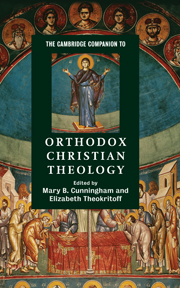Book contents
- Frontmatter
- Who are the Orthodox Christians? A historical introduction
- Part I Doctrine and Tradition
- Part II Contemporary Orthodox Theology: its Formation and Character
- 11 Church Fathers and the shaping of Orthodox theology
- 12 The patristic revival and its protagonists
- 13 The Russian religious revival and its theological legacy
- 14 Some key themes and figures in Greektheological thought
- 15 Personhood and its exponents in twentieth-century Orthodox theology
- 16 The witness of the Church in a pluralistic world: theological renaissance in the Church of Antioch
- 17 Russian theology after totalitarianism
- 18 Orthodox Christianity in the West: the ecumenical challenge
- Glossary
- Bibliography
- Index
- Series list
12 - The patristic revival and its protagonists
from Part II - Contemporary Orthodox Theology: its Formation and Character
Published online by Cambridge University Press: 28 March 2009
- Frontmatter
- Who are the Orthodox Christians? A historical introduction
- Part I Doctrine and Tradition
- Part II Contemporary Orthodox Theology: its Formation and Character
- 11 Church Fathers and the shaping of Orthodox theology
- 12 The patristic revival and its protagonists
- 13 The Russian religious revival and its theological legacy
- 14 Some key themes and figures in Greektheological thought
- 15 Personhood and its exponents in twentieth-century Orthodox theology
- 16 The witness of the Church in a pluralistic world: theological renaissance in the Church of Antioch
- 17 Russian theology after totalitarianism
- 18 Orthodox Christianity in the West: the ecumenical challenge
- Glossary
- Bibliography
- Index
- Series list
Summary
THE ‘NEO-PATRISTIC SYNTHESIS’
The history of Orthodox theology in the twentieth century is everywhere touched by the notion of a patristic revival. What this entails, however, is less than obvious. Predominantly it is bound up with the idea of a 'Neo-patristic synthesis' as characterising modern Orthodox theology, or more precisely the direction that modern Orthodox theology ought to be taking. The actual term seems to have been coined by analogy with 'Neo-Kantianism' (associated with such as Ernst Cassirer and influential on Husserl and Heidegger) or, more significantly perhaps, 'Neo-Thomism', associated with the promotion of Aquinas as a theologian by Pope Leo XIII and his advocacy by the French philosophers tienne Gilson and Jacques Maritain. Like these two movements, the 'Neopatristic synthesis' involved both ressourcement - a recovery of, in this case, the patristic witness - and an engagement with modern problems. It also had a particular polemical context in the reaction - associated especially with the names of two towering figures of twentieth-century Orthodox theology, Fr Georges Florovsky and Vladimir Lossky - against the general character of the 'Russian Religious Renaissance' that culminated in 'sophiology' and its condemnation in the 1930s. The decisive return to patristic sources that Florovsky and Lossky called for is certainly an important and influential aspect of twentieth-century Orthodox theology (which reverberated beyond the Russian émigré circles in which it originated), but is only part of amuch more complex story, which this chapter will attempt to illuminate.
- Type
- Chapter
- Information
- The Cambridge Companion to Orthodox Christian Theology , pp. 188 - 202Publisher: Cambridge University PressPrint publication year: 2008
- 1
- Cited by



